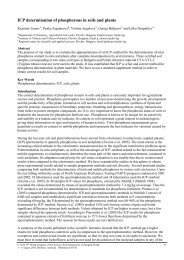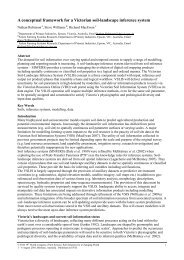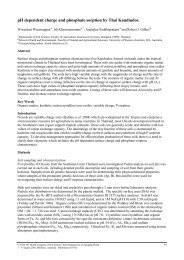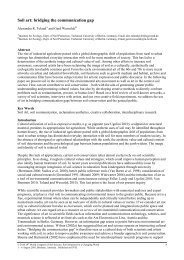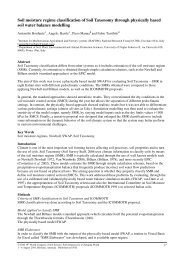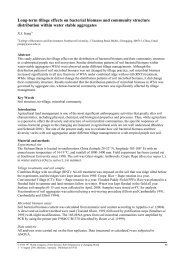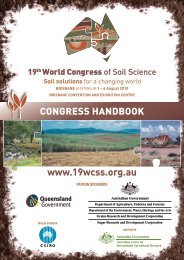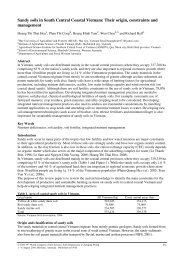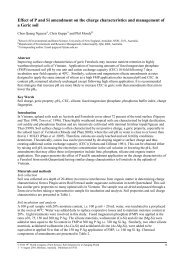Hussain Amjed - International Union of Soil Sciences
Hussain Amjed - International Union of Soil Sciences
Hussain Amjed - International Union of Soil Sciences
You also want an ePaper? Increase the reach of your titles
YUMPU automatically turns print PDFs into web optimized ePapers that Google loves.
70%). Raising the EM sensor above the ground level (7 th and 10 th irrigations) did not increase the correlation<br />
between the catch can and ECa measurements (Table 1).<br />
Table 1. Selected irrigation performance data and correlation between water application and ∆EC a<br />
No. <strong>of</strong><br />
irrigation<br />
after<br />
transplant<br />
Average volume <strong>of</strong><br />
water applied<br />
(mm)<br />
Poor-1<br />
grid<br />
Poor-2<br />
grid<br />
Control<br />
grid<br />
Coefficient <strong>of</strong> uniformity<br />
(CU) calculated from catch can<br />
data (%)<br />
Poor-1<br />
grid<br />
Poor-2<br />
grid<br />
Control<br />
grid<br />
Linear correlations between<br />
point measured depth <strong>of</strong> water<br />
applied and ∆EC a (R 2 )<br />
Poor- 1<br />
grid<br />
Poor-2<br />
grid<br />
4 a 13.9 14.7 19.2 75.4 82.6 84.9 0.00 0.03 0.09<br />
5 a 12.1 11.2 16.9 80.0 72.0 84.6 0.31 0.62 0.39<br />
6 a 13.4 13.2 19.2 48.1 63.7 82.8 0.51 0.40 0.16<br />
7 b 15.4 14.9 23.9 65.1 58.3 88.0 0.27 0.23 0.02<br />
10 b 13.6 12.9 21.5 62.0 46.1 87.3 0.21 0.56 0.04<br />
a = EM on the ground, b = EM elevated above the ground<br />
Control<br />
grid<br />
Relationships between CU calculated by catch can and ∆EC a<br />
The coefficient <strong>of</strong> uniformity (CU) calculated using the catch can measurements for each whole plot was<br />
reasonably well correlated (R 2 ~ 0.6) with the CU calculated using the ∆EC a measurements for both trials<br />
(Figure 2a). However, the correlation was substantially improved (R 2 = 0.93) when the EC a measurements<br />
were taken 0.35 m above the ground surface compared to the on-ground measurements (Figure 2b). This<br />
suggests that variations in ∆EC a observed when the EM sensor is elevated may better reflect the change in<br />
root zone soil moisture with small water applications than on-ground EM measurements.<br />
100<br />
(a)<br />
100<br />
(b)<br />
Measured CU (%) <strong>of</strong> ∆ECa<br />
90<br />
80<br />
70<br />
60<br />
50<br />
40<br />
y = 0.6448x + 30.332<br />
R 2 = 0.60<br />
c<br />
y = 0.4203x + 41.541<br />
R 2 = 0.57<br />
Autumn trial<br />
Winter trial<br />
Measured CU (%) <strong>of</strong> ∆ECa<br />
90<br />
80<br />
70<br />
60<br />
50<br />
40<br />
y = 0.4787x + 41.43<br />
R 2 = 0.43<br />
y = 0.4187x + 38.781<br />
R 2 = 0.93<br />
EM on-ground<br />
EM elevated<br />
40 50 60 70 80 90 100<br />
Measured CU (%) <strong>of</strong> water<br />
40 50 60 70 80 90 100<br />
Measured CU (%) <strong>of</strong> water<br />
Figure 2. Linear correlations <strong>of</strong> CU calculated from catch can measurements and ∆EC a (mS/m) for (a) autumn<br />
and winter trial and (b) on-ground and elevated EM measurements.<br />
Utility <strong>of</strong> whole field ∆EC a measurements to identify system leaks<br />
EC a measurements were generally higher after each irrigation (i.e. due to higher soil-water content) and<br />
when the EM sensor was placed on the ground rather than elevated (i.e. due to a larger sensed soil volume).<br />
Some variations in EC a were also observed associated with proximity to metallic irrigation infrastructure.<br />
However, where ∆EC a was mapped for the whole field (e.g. Figure 3) significant differences in ∆EC a were<br />
found in areas which were not associated with the non-uniformity in sprinkler applications. For example,<br />
higher ∆EC a values were observed at several in-field locations (e.g. 0 × 10.14, 78 × 10.14 and 82 × 10.14 m)<br />
for the 4 th irrigation (Figure 3a) and at the top (i.e. 0 m) <strong>of</strong> the field for the 10 th irrigation (Figure 3b). In<br />
these cases, the elevated ∆EC a readings reflect leakage from the irrigation pipe system and suggest that ∆EC a<br />
could be used to identify gross irrigation system problems.<br />
Conclusions<br />
Correlations between the point measured water applied and the ∆EC a measurements were low, particularly<br />
early in the season when crop water use was small and the uniformity <strong>of</strong> the irrigation relatively high.<br />
Elevating the EM sensor above the ground level did not improve the correlation between the point measured<br />
catch can volume <strong>of</strong> water applied and the ∆EC a . However, the coefficient <strong>of</strong> uniformity calculated using the<br />
© 2010 19 th World Congress <strong>of</strong> <strong>Soil</strong> Science, <strong>Soil</strong> Solutions for a Changing World<br />
1 – 6 August 2010, Brisbane, Australia. Published on DVD.<br />
31



